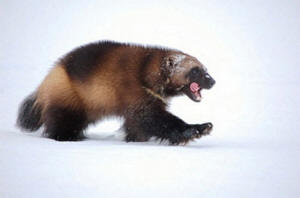US lists wolverine as threatened species, citing climate change
 Send a link to a friend
Send a link to a friend
 [December 01, 2023]
By Steve Gorman [December 01, 2023]
By Steve Gorman
(Reuters) -The North American wolverine, a fierce mountain predator
closely related to badgers and skunks, gained U.S. protection as a
threatened species on Wednesday under a Biden administration policy
citing threats to the animal's snowy habitat from climate change.
The listing under the Endangered Species Act reverses a 2020 Trump
administration determination that such a classification was unwarranted,
leading to a federal court ruling in Montana last year requiring the
U.S. Fish and Wildlife Service to reconsider.
The agency under the Obama administration first proposed listing
wolverines for protection in 2013.
The final rule issued by Fish and Wildlife on Wednesday classifies the
reclusive animal as threatened in the contiguous United States, where
only about 300 are believed to roam the high country of Montana, Idaho,
Wyoming and Washington state.
The designation does not apply in Alaska or Canada, where wolverines
number in the thousands.
Viable populations once roamed expansive tracts of the northern
Cascades, the Rocky Mountains and the Sierra Nevada before widespread
trapping and poisoning severely diminished their numbers and range.
In listing them for protection, government biologists warned that the
few isolated populations remaining in the Rockies and Cascades were
being pushed toward extinction primarily due to rising temperatures and
declining snowpack that has increasingly fragmented wolverines' mountain
habitat.

Environmental groups, which originally petitioned the government to list
wolverines as threatened in 1994, hailed Wednesday's move as long
overdue.
"This long-awaited decision gives the wolverine a fighting chance at
survival," Earthjustice attorney Timothy Preso said in a statement.
The wolverine is the largest land-dwelling species in the mammal family
called Mustelidae, making it a close cousin of weasels, ferrets, skunks
and badgers.
A muscular and solitary carnivore resembling small bears with bushy
tails, the wolverine is known as a ferocious predator capable of taking
down prey many times its own size, while also feeding on anything from
birds to berries.
[to top of second column]
|

A wolverine walks across the snow in a 2009 photo courtesy of the
U.S. Fish and Wildlife Service. The North American wolverine, a
fierce mountain predator closely related to badgers and skunks,
gained U.S. protection as a threatened species on Wednesday under a
Biden administration policy citing threats to the animal's snowy
habitat from climate change. Steve Kroschel/USFWS via REUTERS

The creatures build their dens, reproduce and store food in
high-elevation areas of deep snow. Fish and Wildlife biologists
cited new science showing that backcountry winter recreation and
human disturbance is likely to increasingly infringe on wolverine
habitat as snow cover continues to dwindle.
New research also found that large highways in southern British
Columbia appear to be restricting dispersal of female wolverines
from Canada into the U.S., undermining genetic diversity, according
to the agency.
Regulated trapping in southern Canada for wolverines, prized for
their pelts, may have impaired their populations more than
previously thought as well, the agency said.
Wolverines may cover more than a dozen miles (19 km) a day across
rugged terrain in search of food, believed to be the main factor
driving their movements and explaining the vastness of their natural
home range, according to experts.
The Endangered Species Act generally outlaws killing or harming
animals classified as threatened or endangered without a special
permit.
But the wolverine listing makes exceptions on an interim basis for
mortality caused by "incidental trapping," research activities or
forest management designed to reduce wildfire risks.
As implemented, the wolverine listing gives the government one year
to designate critical habitat where commercial activities will be
restricted to further the animal's recovery.
Noah Greenwald, an endangered species program director for the
conservation group Center for Biological Diversity, said the final
listing marks an improvement over the original 2013 proposal, which
would have allowed for broader exceptions and had ruled out critical
habitat protections as climate change was considered the species'
overriding threat.
(Reporting by Steve Gorman in Los Angeles; Editing by Sandra Maler)
[© 2023 Thomson Reuters. All rights
reserved.]This material
may not be published, broadcast, rewritten or redistributed.
Thompson Reuters is solely responsible for this content. |